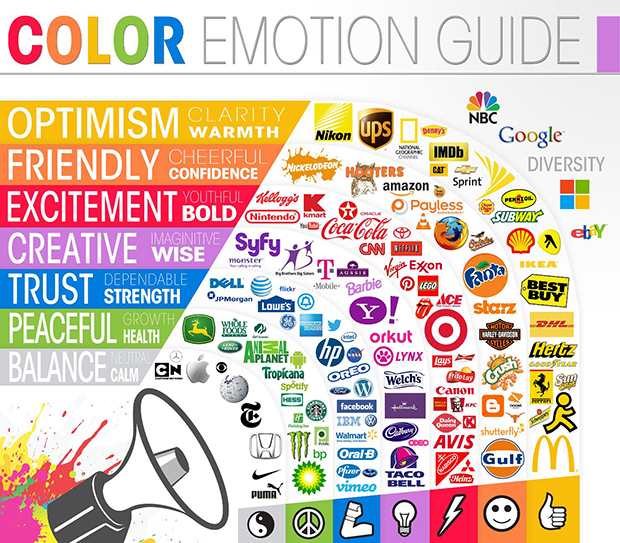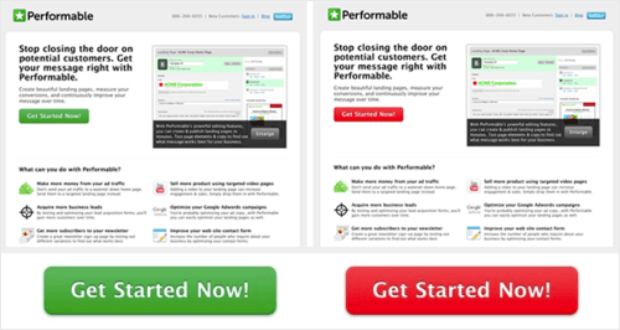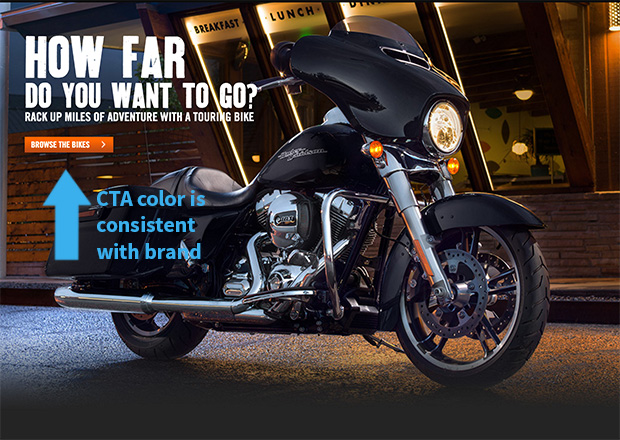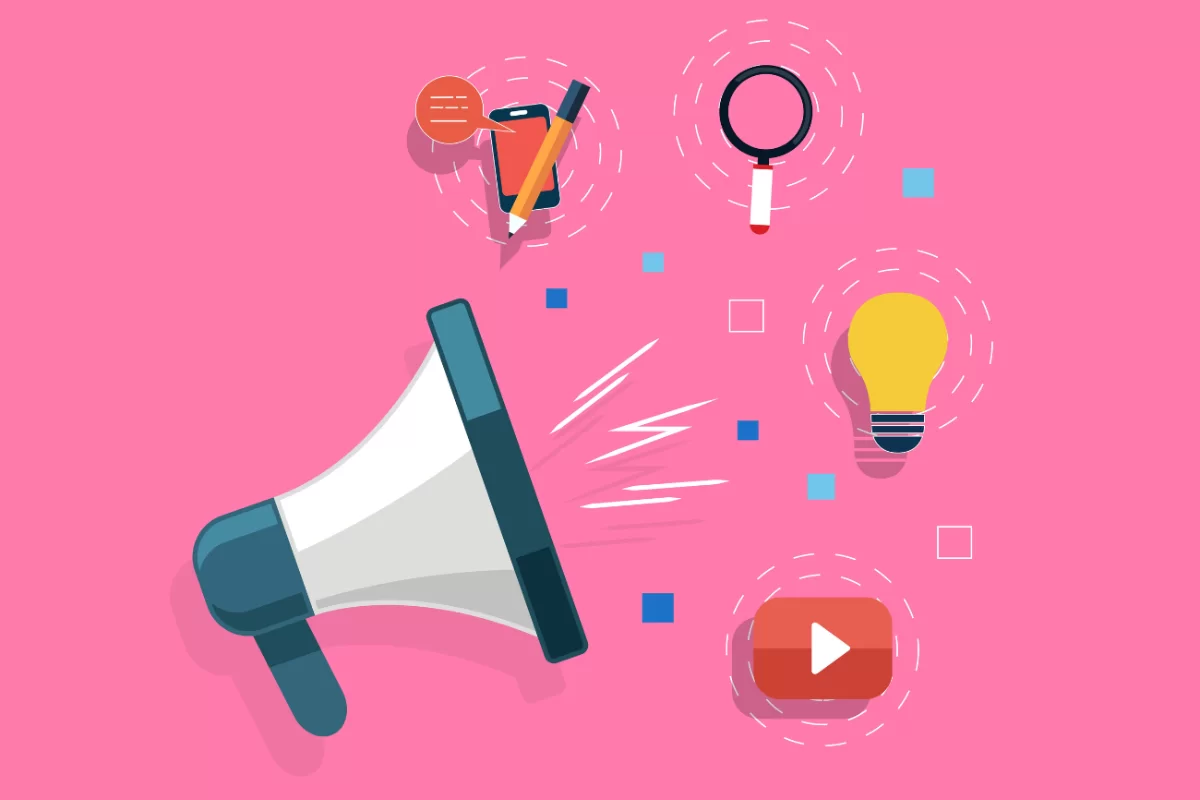Basically, a landing page is designed with a single focused objective – known as a Call to Action (in short CTA). This simplicity is what makes landing pages the best option for increasing conversion rates. Particularly, of your Google AdWords campaigns and lowering your cost of acquiring a lead or sale. The topic of conversion optimization often revolves around CTAs.
With recommendations for improving conversions pointing to various variations. Like in shape, size, color, placement on the page, copy, etc. That said, one factor that’s often neglected – with sometimes dire consequences – is the relevance of the CTAs to the stage of the sales funnel. Or at whatever point your audience is at in the buyer’s journey.
A user’s action can be a lot of things! For example, a request to download an eBook, opt-in to an email list, sign up for a webinar, register for an event, purchase a product, take a live demo/product tour, read another article, share, comment, etc. Often, when your CTAs don’t match the intent of your audience, you’re going to see a sharp decline.
Or rather, a limited lift in conversions for a given piece of content or landing page. Every online marketer will agree that the key to success is conversions: More people clicking on your “Subscribe” or your “Buy Now” buttons equals more leads and sales. But, when it comes to choosing a color for your buttons, well, that’s a highly debated topic (we’ll learn more later on).
What A Call To Action (CTA) Is All About
In general, a Call To Action (CTA) is a button tool used at the end, or sometimes throughout a sales pitch (e.g., a sales letter). Whilst, letting potential clients or even customers know what to do next if at all they’re interested in what your business has to offer them. Obviously, it lets people know the next step to take while doing business with you.
Basically, a Call To Action (in short CTA) is a statement designed to get an immediate response from the person reading or hearing it. For instance, it’s used in business as part of a marketing strategy to get your target market to respond by taking action. But, the truth is that many new business owners don’t have calls to action (CTA) in their marketing and sales pitches.
This is usually for one of these two reasons:
- A belief that the prospect already knows what to do if they’re interested in buying or learning more,
- Concerns that call to action are obnoxious and will annoy the potential client/customer.
Simply put, the Call To Action is an instruction you give to your audience to provoke an immediate response and get them to take action. Whatever the reason, leaving CTAs out of your marketing materials can mean losing prospects and money. Calls to action are essential in directing a prospect to the next step of the sales funnel or process.
Why A Call To Action (CTA) Is Important
If you have been working to improve response rates to your landing page and were wondering if the color of the CTA button made a difference, this guide is for you. Are you finding that your leads and prospects aren’t taking the next step in your sales process? Whether that’s buying or simply requesting more information?
The problem could be a faulty or non-existent Call to Action. First of all, your Call to Action is the chance to motivate your audience to take real steps toward becoming a customer or clients. Keeping in mind, it can be the determining factor between a lead and a conversion. Eventually, many argue that the CTA is the most important part of your site or ad campaign.
So, skipping the Call To Action (CTA) is a grave mistake that won’t bode well for your company. There is a reason the CTA button has become such a staple on-site content and in the ad copy. Below are the key important reasons.
1. It boosts the success of digital marketing
When it comes to online marketing, it’s all about generating hype about your product or service. While at the same time, grabbing the attention of consumers, and encouraging them to seal the deal. Therefore, the CTA is the missing puzzle piece that emphasizes the power of the ad copy.
Meaning, that without the CTA, your copy messaging will fall flat. It won’t have the final hook that inspires customers to take the next step. CTAs are especially important in Pay Per Click (in short PPC) advertising. So, adding a Call to Action to your PPC campaign will help you convey the intent of the campaign to your audience.
In short, emphasize the importance of strong, inspiring CTAs on your marketing team during the creation of ad campaigns. By making the CTA a focal point of your ad creative. Otherwise, you run the risk of your campaign falling on deaf ears. Assumably, for most companies, this isn’t a risk they can afford.
2. A Call to Action motivates your funnels of sales
For your information, CTAs and sales funnels go hand in hand. Whereby, the Calls to Action serve as transitions between the phases of the buyer’s journey. By instructing the user on what to do next, prompting them to take immediate action.
Of course, whether you want your user to visit your blog, give you their contact information, download an eBook, or subscribe to an email list, you must provoke this action. In that case, with a well-placed CTA in the sales funnel. Use CTA best practices such as wording the copy on your button in a way that highlights the benefits.
For example, use “Get More Tips” instead of “Subscribe!” As a matter of fact, the easier you make it to take the next step, the more people will do so. Since your CTA creates a better user experience. And instead of making your audience guess and wonder about how to proceed, you give them the answer in an eye-catching, brightly colored button.
3. A guiding route to your leads and target audience
By guiding your buyers to the next phase of the buying process, you give them the easiest route to the next step. In this case, eliminating the need to solve a problem. After all, buyers are conditioned to seek out and use the CTAs. Therefore, facilitate a smooth buying process by giving the people what they want.
More often, you have just one chance to make a good impression on your target audience. With PPC ads and other forms of digital advertising, there is no time to waste. For one thing, even the smallest missed opportunity can lead customers to pass over your brand in favor of the competition.
In some cases, marketers will utilize multiple calls to action; however, best-practices state that it’s best to only use one call to action to eliminate the paradox of choice. This focuses the audience on that single action you want them to take.
4. A Call to Action is part of what your customers want
Always remember, that CTAs aren’t just important for business – customers want and expect them. Many people depend upon the CTA at the end of the page to take the next step. When they read your ad copy, they are interested in engaging with your brand. And thereby, they always look for the CTA button to learn what to do next.
Another important point is that omitting the CTA can confuse readers and hurt your chances of sealing the conversion. Simply, because they make it easy for customers to do what you want them to do. And that’s good for them and your business.
In short, the right CTA at the perfect moment can push the person in the right direction, sealing the conversion, and ideally creating a loyal customer. It can be a subtle or blunt way to tell your customer that they should ‘take action now’ for more.
5. Your business becomes more predictable and intuitive
Generally speaking, there are some circumstances when you want your brand to be predictable. And notably, predictability makes your company trustworthy and easy to engage with. The CTA is one area where it pays to be as predictable/intuitive.
Your site visitors always look for your “Call Now!,” “Sign Up!,” “Register!,” “Donate!,” or other CTA buttons. And they often feel confused and disappointed when they don’t find it. Having strong calls to action elsewhere are expected parts of the campaign plan too. Such as on social media, websites, the end of videos, copy messaging, digital advertising, etc.
Good CTA is the finishing touch on any type of content. Making it the cherry on top that every user (consciously or subconsciously) wants. Your lead has read or at least scanned your content, and may in one way towards the next step.
How To Create An Effective Call To Action Button
Whether you use your CTA to create a sense of urgency or to gently steer your users toward the checkout line, the important thing is that you use it. Ignoring the CTA is a rookie mistake that could make your numbers drop drastically. Next time you’re creating site content or ad copy, let your call to action shine. And, thereafter, the results will follow.
A CTA can be placed virtually anywhere in and around your content, but your call to action can’t just be placed haphazardly in your sales funnel. Below are some generic CTAs turned better by focusing on the key CTA benefits that the visitors get:

It’s important to realize, that not all CTAs are created equal; it’s not enough to just slap a brightly colored “click here” button throughout your funnel. Not only are various elements crucial to the effectiveness of a call to action, but the performance of your CTAs will vary based on their placement throughout the buyer’s journey.
Creating an effective call to action starts with the little details. It’s easy to create a call to action, but it’s far harder to create a call to action that converts well. Below are some of the most common components that play a part in getting a conversion lift during Call To Action (CTA) creation and A/B testing.
1. CTA Design & Copy
In order for someone to click on a call to action, they first need to see it. Eye-catching designs are helpful, and this is one point where it’s OK to step outside of your brand’s style guide. You want colors that contrast with the rest of your content and that are large enough to stand out over everything else.
Also, you can’t just tell someone to “click” or “submit.” Your copy should use power words and actionable verbs, often personalized (“you”, “your”, “my”) to have the most impact. Here’s a guide to writing CTAs.
2. CTA Proposition Value
Make sure your audience knows exactly what they’re getting when they click. Your call to action should be explicitly clear about what comes next, or about what they’re getting in exchange for taking an action. A Call To Action (CTA) is most effective when it’s wholly relevant to the content it’s placed in, as well as the user’s intent.
As such, it’s best if it delivers the user to a dedicated landing page relevant to the stage of the buyer’s journey, rather than a random website page. For example, a CTA to a Contact Us page won’t be as effective in gathering leads as a CTA that drives the reader to a landing page for a free download.
3. CTA Stages of the Sales Funnel
While most funnels will come in three stages, no two funnels are the same. The buyer’s journey changes depending on your audience, the product or service, the industry, etc.
Some funnels are very short (B2C online retailers for example) while others are much longer. For example, an enterprise-level SaaS like Salesforce (like Freshdesk) isn’t a quick purchase. There’s often a much longer period of awareness and evaluation before a purchase is made. The key stages of the sales funnel to include are the top, middle, and bottom of the funnel.
3.1. Top of the Funnel:
The top of the funnel is the awareness stage. You’re not here to push or promote any specific product or service. Instead, you’re offering a broad range of knowledge intended to educate your audience. They’re looking for answers – sometimes specific, sometimes not so specific. Your job is to create content at this stage that captures their attention.
As well as content that provides them with the answers they seek. At this early evaluation stage, marketers typically use long-form blog content to grab referral and organic traffic and introduce a brand to the audience. Other types include eBooks and white papers, reports, Infographics, resource guides, etc.
3.2. Middle of the Funnel:
The middle of your sales funnel is also known as the evaluation phase. At this point, your audience is aware of your knowledge and offerings. They’re committed to finding a solution, but they don’t quite know what that is yet. For now, they’re simply researching and trying to understand all of the options that are available for solving their problem.
Your goal here is to continue to educate them while also positioning your solutions as the ideal choice. At this stage, it’s not uncommon to use email marketing, segmented by audience and intent, to build a relationship with the audience. Other types include white papers comparison, expert guides, live interactions including webinars, etc.
3.3. Bottom of the Funnel
Just because you’ve moved your audience to the bottom of the funnel into the purchase phase doesn’t mean you’re going to close the lead. They’re certainly ready to buy, and you want to ensure that they buy from you – but it’s far from guaranteed. Hopefully, at this point, you’ve mapped content and CTAs to effectively guide your audience through the lead nurturing process.
According to HubSpot, nurtured leads produce on average a 20% lift in sales vs non-nurtured leads. Further research from Forrester has shown that companies that excel at lead nurturing can generate up to 50% more sales leads at a 33% lower cost. At this phase, you want to leverage content that persuades your audience to make a purchase.
This can include trial downloads, demos, infographics, product literature or buyer guides, further case studies, etc. That aside, can certain colors increase your conversion rate? Well, let’s look at what the research says is the best Call To Action (CTA) button color. So, that you can add a few ideas to your design list.
Why Your CTA Design Color Contrast Matters
To begin with, psychologically, there’s no doubt that color can have a profound effect on people. For instance, the color of a room can affect your mood. Red has been shown to raise blood pressure, increase the speed of respiration and quicken heart rate. Blue, on the other hand, has the opposite effect. It reduces blood pressure/heart rate, slows down respiration, etc.
In one study by researchers at the University of British Columbia, blue was shown to improve creativity, whereas red was shown to increase memory and attention to detail. Due to these findings, it seems that marketers should be able to use the “psychology of color” to create more persuasive logos and branding materials. And many marketers have attempted this.
You may have heard a lot of conflicting advice surrounding conversion optimization, especially when it comes to color. Sure, we all know that urgency, social proof, clear design, and the right lead magnet can all help conversions. But color? That’s a tricky one. You might have come across practitioners who claim that they have found the “secret” to optimizing effectively.
Generally, you’ll see these people belonging to one of these three camps:
- The Generalizers: This type of conversion rate optimizer will religiously commit to following general, broad best practices. However, they won’t dig deep into the psychology of their own customers to fine-tune their campaigns.
- The Pigeonholers: This second type swears by very specific strategies. They will tell you that there are certain “secrets” that are guaranteed to increase your conversion rate. They’ll tell you that a certain color, font, or layout is the way to guarantee your success.
- The Perpetual Testers: The third type won’t commit to any strategy. These optimizers have experimented enough to know that some strategies don’t necessarily work for everyone. Instead, they’ll tell you to test out different things, almost at random, until you find something that works.
According to Optinmonster, for the best Call To Action (CTA) button color, each camp will have a different user…
Consider the following:
- First, the Generalizers will tell you that there are some general truths about color. Some colors work well for certain industries, and there are some colors that you should never use.
- Secondly, the Pigeonholers will swear by one color that converts better than any of the others.
- Thirdly, the Perpetual Testers will say that color might make a difference, but not in any consistent or predictable way.
Clearly, they can’t all be right. Perhaps color doesn’t play a significant role in conversions as we thought. Or perhaps there is something more subtle going on here? In fact, you’ve probably seen at least one infographic like the following somewhere before. Specifically, it illustrates a few Colour Emotion Guides in regard to how various web-based users base their colors:
The above infographic from The Logo Company attempts to show a clear-cut relationship between color and the psychological impact that color has on how we perceive a brand. For example, most restaurants have tried to use the color red in an attempt to stimulate feelings of hunger. However, many psychological reports on the influence of color have mixed results…
For instance, does the color red actually stimulate appetite? The actual studies suggest that red actually inhibits appetite in humans, and it tends to inhibit behavior in general, kind of like a “stop” sign. Red does, however, stimulate feeding in fish.
Related Resource: Fall Back Font In CSS | Steps To Reduce Font Loading Impact
Similarly, in another athlete’s performance study, Olympic wrestlers were randomly assigned blue or red uniforms. The wrestlers in red uniforms significantly out-performed their blue-suited counterparts, indicating that red may make you more aggressive or more competitive. But, in academic environment studies, the color red actually inhibits performance.
All of these results suggest that red can either make you a “winner” or a “loser” (or “hungry” or “not hungry”). In particular, depending on the context (and depending on whether you are a human or a fish). That context only gets more complicated when you look at the cultural meanings associated with color… There is a relationship between the color and the context.
The Right Colour Combination For A Call To Action (CTA) Button
Ultimately, it may seem theoretically possible to choose a “perfect” color: one that’s culturally and demographically appropriate for your buyer persona, and contextually appropriate for your brand. The problem is, there’s no clear way to prove this. Say you change the color of your call-to-action from blue to red, and you see an increase in conversions.
Does this mean that red converts better than blue? Not necessarily! You see, there is more at play here than just the color of the button itself. The variables include not only your brand and your audience, but also the surrounding design. This means, that it’s nearly impossible to isolate all of the variables and definitively prove which color converts best.
To put it another way, let’s first try and understand the way your buyer persona reacts to color. And then, developing a color-based conversion strategy around that would be impractical at best. It would be very difficult, if not impossible, to nail down. You’d spend less effort and see similar results if you simply tried different colors, one at a time until you find one that fits all.
But, that’s not what we are suggesting that you do. There is a much better way to approach this color issue, without having to throw stuff at the wall and see what sticks. If you’re feeling confused about how to use color on your website, don’t worry – you’re not alone. Marketers have been trying to crack the “color code” for decades.
Your Call To Action (CTA) Button Color Needs To Pop
We know that a more prominent, eye-catching call-to-action results in more conversions. Therefore, any color change that increases the visibility of your call-to-action should increase your conversions. If, for example, your button color is low-contrast against your background color, visibility will be poor. Don’t focus on the unknown, but on the known…
But, increase the contrast between the button color and the background color, and boom! Your conversions will go up. On the contrary, no understanding of context or psychological underpinnings is necessary.
In one test, HubSpot found that red buttons worked better than green buttons. Quite possibly, there’s a reason why red converted better than green. And, that’s because green was the dominant color on the page, thus, it created more contrast:
The other factor to consider is the overall color scheme of your page. If one color dominates your page, and that color is also being used for your call-to-action, it won’t stand out. To make your call-to-action really pop, again choose a contrasting color. If you can’t decide if your ‘brand’ would best be supported by a blue, red, or green button, you can try to go with the best.
Your Colors Need To Be On-Brand
We also know from studies that people perceive colors differently depending on how well those colors “match” your brand. Whether or not your brand personality is on point for your customers. And whether your colors are helping or hurting your brand’s perceived personality, actually affects purchase decisions.
For instance, let’s say your brand is tough, rugged, and masculine… like Harley Davidson. Now imagine if they used pink call-to-action buttons instead of a big orange button. It wouldn’t quite work, would it? The complete answer, of course, is that it depends on your target audience. It’s pretty much impossible to prove that any one color is better than any other color.
More so, in terms of persuading any given audience. There are just too many variables, and too much conflicting evidence to come to any universal conclusion. So, instead of trying to find the “perfect” color, go for the color that increases the visibility of your call-to-action. With this simple and proven approach, you can virtually guarantee an increase in conversions.
Your Colors Need To Be Consistent
The other thing marketers know about colors is that we can control the meaning that our users associate with them. Remember those studies we mentioned earlier? How can the color red have a completely different impact depending on the context? The logical reason is because of the association that is created from that context.
For instance, blue is the most commonly used color for hyperlinks. Therefore, most people associate the color blue with hyperlinks. They know that if the text on a page is blue, you can probably click on it. The same is true for call-to-action buttons. You don’t have to choose the color blue, but be aware that whatever color you assign to a button is equal to action.
Use this to your advantage by consistently using that color for all the calls to action on your site. In other words, don’t confuse your users by using the same color for non-action items. Such as headings that aren’t clickable. Similarly, don’t confuse your users by using a lot of different call-to-action colors on the same page.
With that in mind, as you create your Call To Action (CTA) button, always remember, that consistency creates a good website User Experience UX), which is critical for conversion rate optimization in general.
Use Color Choices Plus Text Accessibility Tools
As an example, you can use Coolers to find great color choices that go together. You can use the generator and just click the space bar to get more color choices. Additionally, you can also lock certain colors on the generator if you like them. Then, hit the space bar again to get more colors that work with the colors you locked! There’s also an “explore” section to consider.
Whereby, you can browse and search thousands of color combos. You can search for specific colors or enter a keyword like “winter” and see color combos that match that search. We haven’t been super well-informed about accessibility in the past, but there have been a lot of conversations happening. That said, there are a few other online resources you can use.
Consider using:
The above tools, among many others, are all empowering designers with beautiful and accessible color palettes on the basis of WCAG Guidelines of text and background contrast ratios. Colorzilla is an excellent tool for extracting the color value from any page element. Additionally, WAVE can analyze contrast ratios for all page text elements at once.
NB: On one hand, WCAG 2.0 level AA requires a contrast ratio of at least 4.5:1 for normal text and 3:1 for large text. On the other hand, WCAG 2.1 requires a contrast ratio of at least 3:1 for graphics. And user interface components (such as form input borders). While WCAG Level AAA requires a contrast ratio of at least 7:1 for normal text and 4.5:1 for large text.
Generally, large text is defined as 14 point (typically 18.66px) and bold or larger, or 18 point (typically 24px) or larger. The best thing is to use a tool to check out your color choices and text for accessibility first. And then, unleash the power of utilizing Optinmonster (get started now) if you want to get more subscribers and customers on your website today!
Takeaway;
In general, creating an effective Call To Action (CTA) goes beyond design and copy. It has everything to do with aligning your offer and CTA with your sales funnel to ensure it’s relevant to the audience’s intent. Don’t stop once your CTAs are mapped appropriately, though. Setup follow-up content that moves the target back to the middle of the funnel with an appropriate CTA.
More so, in order to keep them engaged. In addition, maintain the marriage with the customer and turn them into a lead-generating brand ambassador, using CTAs to inspire them to spread the word. So, Do you make CTA placement and creation part of your documented content marketing strategy? Feel free to share your approach to CTAs with us.
More Related Topics:
- Email Marketing Masters Guide In Publishing
- Advertising Explained | Top 10 Best Simplified Methods
- Online Digital Marketing | How Do You Even Get Started?
- Pay Per Click | Actionable Insights to Improve on PPC Ads
- Freshdesk | The Best Helpdesk Tools for Customer Support
Finally, if you’ll need additional support, you can always Contact Us and let us know how we can sort you out. You can also share your additional thoughts, opinions, suggestions, recommendations, or even contribution questions (for FAQ Answers) in our comments section. Likewise, don’t forget to donate in order to support us and motivate our team.








